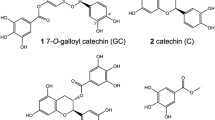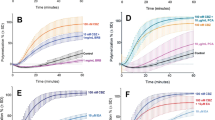Abstract
Purpose
Present study assessed the influence of gallate esterification on the anti-cancer activity of procyanidin B2 (B2) in androgen-dependent human prostate carcinoma LNCaP cells employing B2-3,3′-di-O-gallate (B2-G2), two mono-gallate esters B2-3-O-gallate (B2-3G) and B2-3′-O-gallate (B2-3′G) and the parent compound B2, all isolated from grape seed extract (GSE).
Materials and Methods
Study compounds were isolated from GSE by several chromatographic steps and structures determined by a combination of enzymatic hydrolysis, mass spectrometry and comparisons with standards. Cells, treated with these compounds, were assessed for viability and apoptosis and examined by western blotting.
Results
Gallate esters B2-G2, B2-3G and B2-3′G significantly decreased LNCaP cell viability; however, B2 and gallic acid were ineffective. Furthermore, only B2-G2 also significantly decreased cell growth. Decreases in cell viability were largely due to apoptosis induction with B2-G2 and B2-3′G exhibiting comparable effects, whereas B2-3G was less effective. In mechanistic studies, B2-G2 and B2-3′G treatments caused caspases-9 and -3 and PARP cleavage, and down-regulated Bcl-2, Bcl-Xl and androgen receptor levels.
Conclusion
Together, our findings demonstrate anti-PCA efficacy of B2-G2 and suggest that a gallate ester moiety at 3′ position of procyanidin B2 contributes more extensively toward the biological activity of the di-gallate ester than esterification of position 3.





Similar content being viewed by others
Abbreviations
- AR:
-
androgen receptor
- B2:
-
procyanidin B2
- B2-G2 :
-
procyanidin B2-3,3′-di-O-gallate
- B2-3′G:
-
procyanidin B2-3′-O-gallate
- B2-3G:
-
procyanidin B2-3-O-gallate
- GSE:
-
grape seed extract
- PARP:
-
poly (ADP-ribose) polymerase
- PCA:
-
prostate cancer
- SEC:
-
size-exclusion chromatography
REFERENCES
Brawley OW, Ankerst DP, Thompson IM. Screening for prostate cancer. CA Cancer J Clin. 2009;59:264–73.
Jemal A, Siegel R, Ward E, Hao Y, Xu J, Thun MJ. Cancer statistics, 2009. CA Cancer J Clin. 2009;59:225–49.
Nguyen MM, Wang Z. Manipulation of androgens and alterations in the androgen receptor axis in prostate cancer. Minerva Urol Nefrol. 2008;60:15–29.
Kawakami J, Cowan JE, Elkin EP, Latini DM, DuChane J, Carroll PR, et al. Androgen-deprivation therapy as primary treatment for localized prostate cancer:data from Cancer of the Prostate Strategic Urologic Research Endeavor (CaPSURE). Cancer 2006;106:1708–14.
Yuan X, Balk SP. Mechanisms mediating androgen receptor reactivation after castration. Urol Oncol. 2009;27:36–41.
Stratton KL, Chang SS. Locally advanced prostate cancer: the role of surgical management. BJU Int. 2009;104:449–54.
Reynolds MA. Molecular alterations in prostate cancer. Cancer Lett. 2008;271(1):13–24.
Schulz WA, Hoffmann MJ. Epigenetic mechanisms in the biology of prostate cancer. Semin Cancer Biol. 2009;19:172–80.
Trichopoulou A, Lagiou P, Kuper H, Trichopoulos D. Cancer and Mediterranean dietary traditions. Cancer Epidemiol Biomarkers Prev. 2000;9:869–73.
Grant WB. A multicountry ecologic study of risk and risk reduction factors for prostate cancer mortality. Eur Urol. 2004;45:271–9.
Raskin I, Ribnicky DM, Komarnytsky S, Ilic N, Poulev A, Borisjuk N, et al. Plants and human health in the twenty-first century. Trends Biotechnol. 2002;20:522–31.
Dhiman RK, Chawla YK. Herbal medicines for liver diseases. Dig Dis Sci. 2005;50:1807–12.
Surh YJ. Cancer chemoprevention with dietary phytochemicals. Nat Rev Cancer. 2003;3:768–80.
Sagar SM, Yance D, Wong RK. Natural health products that inhibit angiogenesis: a potential source for investigational new agents to treat cancer-Part 1. Curr Oncol. 2006;13:14–26.
Bagchi D, Bagchi M, Stohs S, Ray SD, Sen CK, Preuss HG. Cellular protection with proanthocyanidins derived from grape seeds. Ann N Y Acad Sci. 2002;957:260–70.
Yoshimura Y, Nakazawa H, Yamaguchi F. Evaluation of the NO scavenging activity of procyanidin in grape seed by use of the TMA-PTIO/NOC 7 ESR system. J Agric Food Chem. 2003;51(22):6409–12.
Yamaguchi F, Yoshimura Y, Nakazawa H, Ariga T. Free radical scavenging activity of grape seed extract and antioxidants by electron spin resonance spectrometry in an H(2)O(2)/NaOH/DMSO system. J Agric Food Chem. 1999;47:2544–8.
Bagchi D, Garg A, Krohn RL, Bagchi M, Tran MX, Stohs SJ. Oxygen free radical scavenging abilities of vitamins C and E, and a grape seed proanthocyanidins extract in vitro. Res Commun Mol Pathol Pharmacol. 1997;95:179–89.
Tyagi A, Agarwal R, Agarwal C. Grape seed extract inhibits EGF-induced and constitutively active mitogenic signaling but activates JNK in human prostate carcinoma DU145 cells: possible role in antiproliferation and apoptosis. Oncogene 2003;22:1302–16.
Singh RP, Tyagi AK, Dhanalakshmi S, Agarwal R, Agarwal C. Grape seed extract inhibits advanced human prostate tumor growth and angiogenesis and upregulates insulin-like growth factor binding protein-3. Int J Cancer. 2004;108:733–40.
Agarwal C, Singh RP, Dhanalakshmi S, Agarwal R. Anti-angiogenic efficacy of grape seed extract in endothelial cells. Oncol Rep. 2004;11:681–5.
Kaur M, Singh RP, Gu M, Agarwal R, Agarwal C. Grape seed extract inhibits in vitro and in vivo growth of human colorectal carcinoma cells. Clin Cancer Res. 2006;12:6194–202.
Raina K, Singh RP, Agarwal R, Agarwal C. Oral grape seed extract inhibits prostate tumor growth and progression in TRAMP mice. Cancer Res. 2007;67:5976–82.
Kijima I, Phung S, Hur G, Kwok SL, Chen S. Grape seed extract is an aromatase inhibitor and a suppressor of aromatase expression. Cancer Res. 2006;66:5960–7.
Kowalczyk MC, Walaszek Z, Kowalczyk P, Kinjo T, Hanausek M, Slaga TJ. Differential effects of several phytochemicals and their derivatives on murine keratinocytes in vitro and in vivo: implications for skin cancer prevention. Carcinogenesis 2009;30:1008–15.
Singletary KW, Meline B. Effect of grape seed proanthocyanidins on colon aberrant crypts and breast tumors in a rat dual-organ tumor model. Nutr Cancer. 2001;39:252–8.
Nomoto H, Iigo M, Hamada H, Kojima S, Tsuda H. Chemoprevention of colorectal cancer by grape seed proanthocyanidin is accompanied by a decrease in proliferation and increase in apoptosis. Nutr Cancer. 2004;49:81–8.
Ye X, Krohn RL, Liu W, Joshi SS, Kuszynski CA, McGinn TR, et al. The cytotoxic effects of a novel IH636 grape seed roanthocyanidin extract on cultured human cancer cells. Mol Cell Biochem. 1999;196:99–108.
Zhao J, Wang J, Chen Y, Agarwal R. Anti-tumor-promoting activity of a polyphenolic fraction isolated from grape seeds in the mouse skin two-stage initiation-promotion protocol and identification of procyanidin B5-3′-gallate as the most effective antioxidant constituent. Carcinogenesis 1999;20:1737–45.
Prasain JK, Peng N, Dai Y, Moore R, Arabshahi A, Wilson L, et al. Liquid chromatography tandem mass spectrometry identification of proanthocyanidins in rat plasma after oral administration of grape seed extract. Phytomedicine 2009;16:233–43.
Monagas M, Gómez-Cordovés C, Bartolomé B, Laureano O, Ricardo da Silva JM. Monomeric, oligomeric, and polymeric flavan-3-ol composition of wines and grapes from Vitis vinifera L. Cv. Graciano, Tempranillo, and Cabernet Sauvignon. J Agric Food Chem. 2003;51:6475–81.
Auger C, Gérain P, Laurent-Bichon F, Portet K, Bornet A, Caporiccio B, et al. Phenolics from commercialized grape extracts prevent early atherosclerotic lesions in hamsters by mechanisms other than antioxidant effect. J Agric Food Chem. 2004;52:5297–302.
Eng ET, Ye J, Williams D, Phung S, Moore RE, Young MK, et al. Suppression of estrogen biosynthesis by procyanidin dimmers in red wine and grape seeds. Cancer Res. 2003;63:8516–22.
Kaur M, Velmurugan B, Rajamanickam S, Agarwal R, Agarwal C. Gallic acid, an active constituent of grape seed extract, exhibits anti-proliferative, pro-apoptotic and anti-tumorigenic effects against prostate carcinoma xenografts growth in nude mice. Pharm Res. 2009;26:2133–40.
Raina K, Rajamanickam S, Deep G, Singh M, Agarwal R, Agarwal C. Chemopreventive effects of oral gallic acid feeding on tumor growth and progression in TRAMP mice. Mol Cancer Ther. 2008;7:1258–67.
Agarwal C, Veluri R, Kaur M, Chou SC, Thompson JA, Agarwal R. Fractionation of high molecular weight tannins in grape seed extract and identification of procyanidin B2-3, 3′-di-O-gallate as a major active constituent causing growth inhibition and apoptotic death of DU145 human prostate carcinoma cells. Carcinogenesis 2007;28:1478–84.
Veluri R, Singh RP, Liu Z, Thompson JA, Agarwal R, Agarwal C. Fractionation of grape seed extract and identification of gallic acid as one of the major active constituents causing growth inhibition and apoptotic death of DU145 human prostate carcinoma cells. Carcinogenesis 2006;27:1445–53.
Kaur M, Agarwal R, Agarwal C. Grape seed extract induces anoikis and caspase-mediated apoptosis in human prostate carcinoma LNCaP cells: possible role of ataxia telangiectasia mutated-p53 activation. Mol Cancer Ther. 2006;5:1265–74.
Gu L, Kelm MA, Hammerstone JF, Beecher G, Holden J, Haytowitz D, et al. Screening of foods containing proanthocyanidins and their structural characterization using LC-MS/MS and thiolytic degradation. J Agric Food Chem. 2003;51:7513–21.
Friedrich W, Eberhardt A, Galensa R. (2000) Investigation of proanthocyanidins by HPLC with electrospray ionization mass spectrometry. Eur Food Res Technol. 2000;211:56–64.
Sano A, Yamakoshi J, Tokutake S, Tobe K, Kubota Y, Kikuchi M. Procyanidin B1 is detected in human serum after intake of proanthocyanidin-rich grape seed extract. Biosci Biotechnol Biochem. 2003;67:1140–3.
Saito A, Mizushina Y, Ikawa H, Yoshida H, Doi Y, Tanaka A, et al. Systematic synthesis of galloyl-substituted procyanidin B1 and B2, and their ability of DPPH radical scavenging activity and inhibitory activity of DNA polymerases. Bioorg Med Chem. 2005;13:2759–71.
Pop C, Salvesen GS. Human caspases: activation, specificity, and regulation. J Biol Chem. 2009;284:21777–81.
Duriez PJ, Shah GM. Cleavage of poly(ADP-ribose) polymerase: a sensitive parameter to study cell death. Biochem Cell Biol. 1997;75:337–49.
Tait SW, Green DR. Caspase-independent cell death: leaving the set without the final cut. Oncogene 2008;27:6452–61.
McCarthy NJ, Whyte MK, Gilbert CS, Evan GI. Inhibition of Ced3/ICE related proteases does not prevent cell death induced by oncogenes, DNA damage, or the Bcl-2 homologue Bak. J Cell Biol. 1997;136:215–27.
Borner C, Monney L. Apoptosis without caspases: an inefficient molecular guillotine? Cell Death Differ. 1999;6:497–507.
Yip KW, Reed JC. Bcl-2 family proteins and cancer. Oncogene 2008;27:6398–406.
Lomonosova E, Chinnadurai G. BH3-only proteins in apoptosis and beyond: an overview. Oncogene 2008;27 Suppl 1:S2–S19.
ACKNOWLEDGEMENTS
This study was supported by the National Cancer Institute, NIH RO1 grant CA091883.
Author information
Authors and Affiliations
Corresponding author
Rights and permissions
About this article
Cite this article
Chou, SC., Kaur, M., Thompson, J.A. et al. Influence of Gallate Esterification on the Activity of Procyanidin B2 in Androgen-Dependent Human Prostate Carcinoma LNCaP Cells. Pharm Res 27, 619–627 (2010). https://doi.org/10.1007/s11095-009-0037-6
Received:
Accepted:
Published:
Issue Date:
DOI: https://doi.org/10.1007/s11095-009-0037-6




